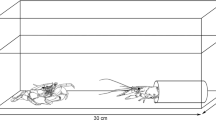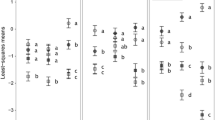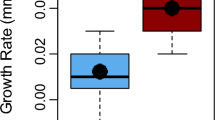Abstract
Non-native crayfishes can have large impacts on biodiversity and the provisioning of ecosystem services in freshwaters. In 2015 we discovered an established population of the globally widespread red swamp crayfish (Procambarus clarkii) in the North Shore Channel of the Chicago Area Waterway System. This population overlaps with a population of rusty crayfish (Faxonius rusticus), a previous invader that is widely distributed and usually the dominant crayfish species across the Great Lakes region. If P. clarkii continues to spread in the Great Lakes region it will frequently encounter F. rusticus. Factors such as water clarity, competition for food when limited, and susceptibility to predation may alter P. clarkii’s ability to become established and spread. We sampled the overlapping populations and found that P. clarkii are significantly larger than F. rusticus. Next, we conducted lab experiments to examine the outcomes of competition between these species for shelter and food. F. rusticus were significantly more likely to seek shelter when threatened, while P. clarkii were significantly more likely to respond aggressively. P. clarkii won more competitions for food. Finally, we conducted field experiments to investigate rates of predation on each species and found that P. clarkii are predated significantly more often. Our results suggest that P. clarkii is dominant in interactions with F. rusticus but that higher rates of predation, likely occurring because P. clarkii is less likely to flee from threats, mitigate these benefits. We suggest that P. clarkii will dominate crayfish communities in water with low clarity, but not in clear-water habitats where visual predators are more effective.



Similar content being viewed by others
References
Alonso F, Martínez R (2006) Shelter competition between two invasive crayfish species: a laboratory study. Bulletin François de la Peche et de la Pisciculture 380–381:1121–1132
Behm J (2009) Bleach set to eradicate Germantown’s invasive crayfish. Milwaukee, Wisconsin Journal Sentential
Behringer DC, Hart JE (2017) Competition with stone crabs drives juvenile spiny lobster abundance and distribution. Oecologia 184:205–218
Bunk H, Van Egeren S (2014) Containment. In: Control and eradication of ambitious architect: Procambarus clarkii, The Red Swamp Crayfish
Butler M, Stein R (1985) An analysis of the mechanisms governing species replacement in crayfish. Oecologia 66(2):168–177
Capelli GM, Magnuson JJ (1983) Morphoedaphic and biogeographic analysis of crayfish distribution in Northern Wisconsin. J Crustac Biol 3(4):548–564
Charlebois PM, Lamberti GA (1996) Invading crayfish in a Michigan stream: direct and indirect effects of periphyton and macroinvertabrates. J N Am Benthol Soc 15(4):551–563
Childress MJ, Herrnkind WF (1994) The behavior of Caribbean juvenile spiny lobster in Florida Bay: seasonality, ontogeny and sociality. Bull Mar Sci 54(3):819–827
Clarke Murray CC, Gartner H, Gregr EJ, Chan K, Pakhomov E, Therriault TW (2014) Spatial distribution of marine invasive species: environmental, demographic and vector drivers. Divers Distrib 20:824–836
Correia AM, Ferreira O (1995) Burrowing behavior of the introduced red swamp crayfish Procambarus clarkii (Decapoda: Cambaridae) in Portugal. J Crustac Biol 15(2):248–257
Crall AW, Newman GJ, Stohlgren TJ, Jarnevich CS, Evangelista P, Guenther D (2006) Evaluating dominance as a component of non-native species invasions. Divers Distrib 12:195–204
Crandall KA, De Grave S (2017) An updated classification of the freshwater crayfishes (Decapoda: Astacidea) of the world, with a complete species list. J Crustac Biol 37(5):615–653
Creed RP Jr, Reed JM (2004) Ecosystem engineering by crayfish in a headwater stream community. J N Am Benthol Soc 23(2):224–236
Crowl TA (1987) Effects of crayfish size, orientation, and movement on the reactive distance of largemouth bass foraging in clear and turbid water. Hydrobiologia 183(2):133–140
DiDonato GT, Lodge DM (1993) Species replacements among Orconectes crayfishes in Wisconsin lakes: the role of predation by fish. Can J Fish Aquat Sci 50:1484–1488
Donato R, Rollandin M, Favaro L, Ferrarese A, Pessani D, Ghia D (2018) Habitat use and population structure of the invasive red swamp crayfish Procambarus clarkii (Girard, 1852) in a protected area in northern Italy. Knowl Manag Aquat Ecosyst 419:12
Dunn JC, McClymont HE, Christmas M, Dunn AM (2008) Competition and parasitism in the native white clawed crayfish Austropotamobius pallipes and the invasive signal crayfish Pacifastacus leniusculus in the UK. Biol Invasions 11(2):315–324
Egly RM, Annis GM, Chadderton WL, Peters JA, Larson ER (2019) Predicting the potential distribution of the non-native red swamp crayfish Procambarus clarkii in the Laurentian Great Lakes. J Great Lakes Res 45(1):150–159
Figler MH, Cheverton HM, Blank GS (1999) Shelter competition in juvenile red swamp crayfish (Procambarus clarkii): the influences of sex differences, relative size, and prior residence. Aquaculture 178(1–2):63–75
Fletcher RJ Jr (2007) Species interactions and population density mediate the use of social cues for habitat selection. J Anim Ecol 76(3):598–606
Garvey JE, Stein RA, Thomas TM (1994) Assessing how fish predation and interspecific prey competition influence crayfish assemblage. Ecology 75(2):532–547
Gherardi F, Daniels WH (2004) Agonism and shelter competition between invasive and indigenous crayfish species. Can J Zool 82:1923–1932
[GLEC] Great Lakes Environment Center (2006) Water quality monitoring of Saginaw and Grand Traverse Bays. Michigan Department of Environmental Quality report #MI/DEQ/WB-06/096. https://www.michigan.gov/documents/deq/wrd-swas-9304bayreport_445627_7.pdf
Hein CL, Vander Zanden MJ, Magnuson JJ (2007) Intensive trapping and increased fish predation cause massive population decline of an invasive crayfish. Freshw Biol 52:1134–1146
Hill L (2000) The Chicago river: a natural and unnatural history. Southern Illinois University Press, Carbondale
Hill AM, Lodge DM (1999) Replacement of resident crayfishes by an exotic crayfish: the roles of competition and predation. Ecol Appl 9(2):678–690
Issa FA, Adamson DJ, Edwards DH (1999) Dominance hierarchy formation in juvenile crayfish Procambarus clarkii. J Exp Biol 202:3497–3506
Karavanich C, Atema J (1998) Individual recognition and memory in lobster dominance. Anim Behav 56:1553–1560
Keller RP, Masoodi A, Shackleton RT (2018) The impact of invasive aquatic plants on ecosystem services and human well-being in Wular Lake, India. Reg Environ Change 18:847–857
Kershner MW, Lodge DM (1995) Effects of littoral habitat and fish predation on the distribution of an exotic crayfish, Orconectes rusticus. Freshw Sci 14(3):414–422
Klocker CA, Strayer DL (2004) Interactions among an invasive crayfish (Orconectes rusticus), a native crayfish (Orconectes limosus), and native bivalves (Sphaeriidae and Unionidae). Northeast Nat 11(2):167–178
Kreps TA, Larson ER, Lodge DM (2014) Do invasive rusty crayfish (Orconectes rusticus) decouple littoral and pelagic energy flows in lake food webs? Freshw Sci 35(1):103–113
Lodge DM, Kershner MW, Aloi JE, Covich AP (1994) Effects of an omnivorous crayfish (Orconectes rusticus) on a freshwater littoral food source. Ecology 75(5):1265–1281
Lodge DM, Taylor CA, Holdich DM, Skurdal J (2000) Nonindigenous crayfishes threaten North American freshwater biodiversity: lessons from Europe. Fisheries 25(8):7–20
Mazlum Y (2007) Effects of temperature on the survival and growth of two cambarid crayfish juveniles. Crustaceana 80(8):947–954
Nagy R, Fusaro A, Conard W (2018) Procambarus clarkii (Girard, 1852). U.S Geological Survey, Nonindigenous Aquatic Species Database, Gainesvill, FL
Olden JD, McCarthy JM, Maxted JT, Fetzer MW, Vander Zanden MJ (2006) The rapid spread of rusty crayfish (Orconectes rusticus) with observations on native crayfish declines in Wisconsin (U.S.A.) over the past 130 years. Biol Invasions 8(8):1621–1628
Oreska MPJ, Aldridge DC (2011) Estimating the financial costs of freshwater invasive species in Great Britain: a standardized approach to invasive species costing. Biol Invasions 13:305–319
Pavey CR, Fielder DR (1996) The influence of size differential on agonistic behaviour in the freshwater crayfish, Cherax cuspidatus (Decapoda: Parastacidae). J Zool 238:445–457
Pejchar L, Mooney HA (2009) Invasive species, ecosystem services and human well-being. Trends Ecol Evol 24(9):497–504
Peters JA, Lodge DM (2013) Habitat, predation, and coexistence between invasive and native crayfishes: prioritizing lakes for invasion prevention. Biol Invasions 15:2489–2502
Peters JA, Cooper MJ, Creque SM, Kornis MS, Maxted JT, Pretty WL, Schueler FW, Simon TP, Taylor CA, Thoma RF, Uzarski DG, Lodge DM (2014) Historical changes and current status of crayfish diversity and distribution in the Laurentian Great Lakes. J Great Lakes Res 40(1):35–46
Pimental D, Zuniga R, Morrison D (2005) Update on the environmental and economic costs associated with alien-invasive species in the United States. Ecol Econ 52(3):273–288
Qualls T, Harris HJ, Harris V (2013) The state of the Bay: the condition of the Bay of Green Bay/Lake Michigan 2013. University of Wisconsin Sea Grant Institute. http://www.seagrant.wisc.edu/home/Portals/0/Files/Habitats%20and%20Ecosystems/SotBReport.pdf
Rabeni CF (1985) Resource partitioning by stream-dwelling crayfish: the influence of body size. Am Midl Nat 113(1):20–29
Ramalho RO, Anastácio P (2015) Factors inducing overland movement of invasive crayfish (Procambarus clarkii) in a ricefield habitat. Hydrobiologia 746(1):135–146
R Core Development Team (2015) R: a language and environment for statistical computing. R Foundation for Statistical Computing, Vienna
Scrivner JCE (1971) Agonistic behavior of the American lobster Homarus americanus (Milne-Edwards). Fish Res Board Can Tech 235:128
Smart AC, Harper DM, Malaisse F, Schmitz S, Coley S, Gouder de Beauregard AC (2002) Feeding of the exotic Lousiana red swamp crayfish, Procambarus clarkii (Crustacea, Decapoda), in an African tropical lake: Lake Naivasha, Kenya. Hydrobiologia 488:129–142
Smith K, Roth BM, Herbst SJ, Thoma RF, Popoff N, Hayes DB, Jones ML (2018) Assessment of invasion risks for red swamp crayfish (Procambarus clarkii) in Michigan. Management of Biological Invasions, USA, p 9
Souty-Grosset C, Anastácio PM, Aquiloni L, Banha F, Choquer J, Chucholl C, Tricarico E (2016) The red swamp crayfish Procambarus clarkii in Europe: impacts on aquatic ecosystems and human well-being. Limnologica 58:78–93
Statzner B, Fièvet E, Champagne J, Morel R, Herouin E (2000) Crayfish as geomorphic agents and ecosystem engineers: biological behavior affects sand and gravel erosion in experimental streams. Limnol Oceanogr 45:1030–1040
Stein RA (1976) Sexual dimorphism in crayfish chelae: functional significance linked to reproductive activities. Can J Zool 54(2):220–227
Stein RA (1977) Selective predation, optimal foraging and the predator-prety interaction between fish and crayfish. Ecology 58:1237–1253
Szela K, Perry WL (2013) Laboratory competition hierarchies between potentially invasive rusty crayfish (Orconectes rusticus) and native crayfishes of conservation concern. Am Midl Nat 169(2):345–353
Taylor CA, Schuster GA, Wylie DB (2015) Field guide to crayfishes of the Midwest. Manual 15. Illinois Natural History Survey, Champaign, IL
Tierney AJ, Gunaratne C, Jennison K, Monroy V, Donnelly L (2008) Behavioral correlates of alternate male forms (form I and form II) in the crayfish Orconectes rusticus. J Crustac Biol 28(4):596–600
[USGS] United States Geological Society, Nonindigenous aquatic species (2019) Crustaceans, crayfish map
Weis JS (2010) The role of behavior in the success of invasive crustaceans. Mar Freshw Behav Physiol 43(2):83–98
Westman K, Savolainen R, Julkunen M (2002) Replacement of the native crayfish Astacus astacus by the introduced species Pacifastacus leniusculus in a small, enclosed Finnish lake: a 30-year study. Ecography 25(1):53–73
Wilson KA, Magnuson JJ, Lodge DM, Hill AM, Kratz TK, Perry WL, Willis TV (2004) A long-term rusty crayfish (Orconectes rusticus) invasion: dispersal patterns and community change in a north temperate lake. Can J Aquat Sci 61:2255–2266
Wisconsin Division of Natural Resources (WIDNR). Aquatic invasive species, red swamp crayfish. https://dnr.wi.gov/lakes/invasives/AISLists.aspx?species=RED_SWAMP_CRAYF
Yue GH, Li J, Bai Z, Wang CM, Feng F (2010) Genetic diversity and population structure of the invasive alien red swamp crayfish. Biol Invasions 12:2697–2706
Acknowledgements
The authors wish to thank the following for field and lab assistance: Jonathon Brenner, Shehla Chowdhury, Gabriel Habeeb, Trent Henry, Alexander Papaioannou, Jenny Par, and John Zink. Martin Berg and Victoria Prescott provided statistical analysis assistance. The Illinois Department of Natural Resources (Grant No. F16AP00241) and US Fish and Wildlife Service provided funding for this research.
Author information
Authors and Affiliations
Corresponding author
Additional information
Publisher's Note
Springer Nature remains neutral with regard to jurisdictional claims in published maps and institutional affiliations.
Electronic supplementary material
Below is the link to the electronic supplementary material.
Rights and permissions
About this article
Cite this article
O’Shaughnessey, E.M., Keller, R.P. When invaders collide: competition, aggression, and predators affect outcomes in overlapping populations of red swamp (Procambarus clarkii) and rusty (Faxonius rusticus) crayfishes. Biol Invasions 21, 3671–3683 (2019). https://doi.org/10.1007/s10530-019-02079-6
Received:
Accepted:
Published:
Issue Date:
DOI: https://doi.org/10.1007/s10530-019-02079-6




